Hyundai Tucson 2020 Owner's Manual - RHD (UK, Australia)
Manufacturer: HYUNDAI, Model Year: 2020, Model line: Tucson, Model: Hyundai Tucson 2020Pages: 637, PDF Size: 64.45 MB
Page 391 of 637
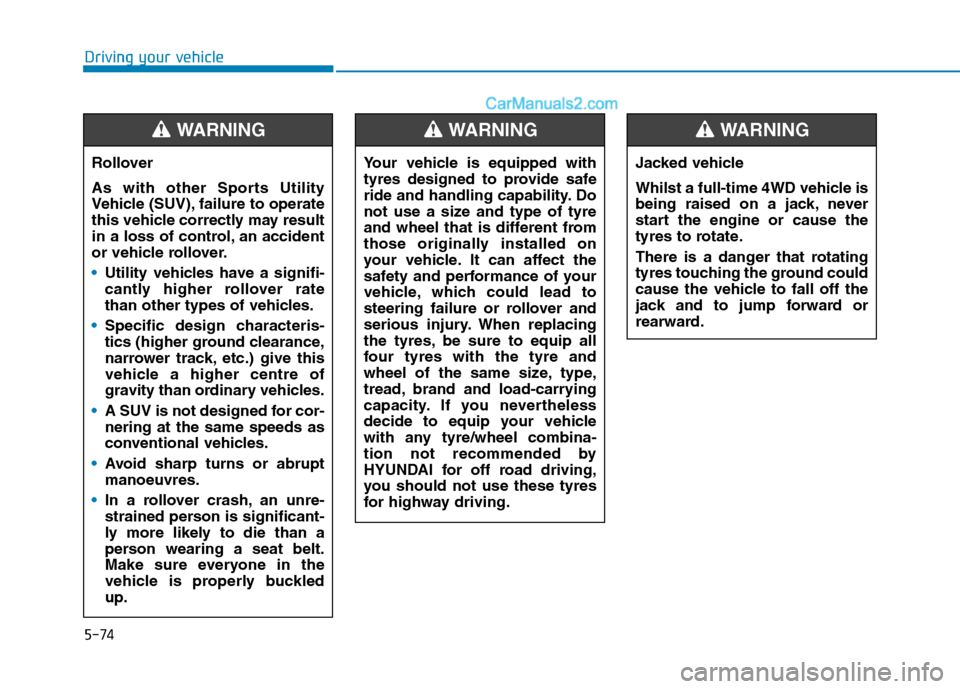
5-74
Driving your vehicle
Rollover
As with other Sports Utility
Vehicle (SUV), failure to operate
this vehicle correctly may result
in a loss of control, an accident
or vehicle rollover.
Utility vehicles have a signifi-
cantly higher rollover rate
than other types of vehicles.
Specific design characteris-
tics (higher ground clearance,
narrower track, etc.) give this
vehicle a higher centre of
gravity than ordinary vehicles.
A SUV is not designed for cor-
nering at the same speeds as
conventional vehicles.
Avoid sharp turns or abrupt
manoeuvres.
In a rollover crash, an unre-
strained person is significant-
ly more likely to die than a
person wearing a seat belt.
Make sure everyone in the
vehicle is properly buckled
up.
WARNING
Your vehicle is equipped with
tyres designed to provide safe
ride and handling capability. Do
not use a size and type of tyre
and wheel that is different from
those originally installed on
your vehicle. It can affect the
safety and performance of your
vehicle, which could lead to
steering failure or rollover and
serious injury. When replacing
the tyres, be sure to equip all
four tyres with the tyre and
wheel of the same size, type,
tread, brand and load-carrying
capacity. If you nevertheless
decide to equip your vehicle
with any tyre/wheel combina-
tion not recommended by
HYUNDAI for off road driving,
you should not use these tyres
for highway driving.
WARNING
Jacked vehicle
Whilst a full-time 4WD vehicle is
being raised on a jack, never
start the engine or cause the
tyres to rotate.
There is a danger that rotating
tyres touching the ground could
cause the vehicle to fall off the
jack and to jump forward or
rearward.
WARNING
Page 392 of 637
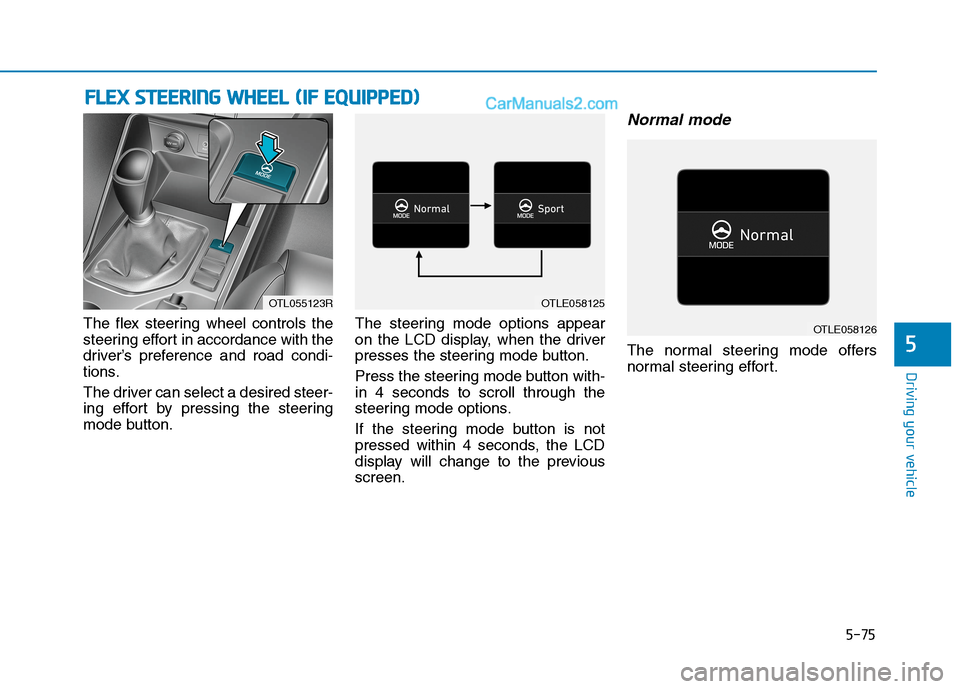
5-75
Driving your vehicle
The flex steering wheel controls the
steering effort in accordance with the
driver’s preference and road condi-
tions.
The driver can select a desired steer-
ing effort by pressing the steering
mode button.The steering mode options appear
on the LCD display, when the driver
presses the steering mode button.
Press the steering mode button with-
in 4 seconds to scroll through the
steering mode options.
If the steering mode button is not
pressed within 4 seconds, the LCD
display will change to the previous
screen.
Normal mode
The normal steering mode offers
normal steering effort.
F FL
LE
EX
X
S
ST
TE
EE
ER
RI
IN
NG
G
W
WH
HE
EE
EL
L
(
(I
IF
F
E
EQ
QU
UI
IP
PP
PE
ED
D)
)
5
OTL055123ROTLE058125
OTLE058126
Page 393 of 637

5-76
Driving your vehicle
Sport mode
The sport steering mode offers high
steering effort, making the wheel
steering heavier. The sport steering
mode is often used for driving on a
highway.When the driver presses the
steering mode button whilst
driving, it changes the steer-
ing mode option on the LCD
display. However, it does not
immediately change the steer-
ing effort, for your safety.
Upon completing the wheel
steering, the steering tension
is automatically set to the
selected mode.
Pay great caution whilst
changing through modes,
when the vehicle is in motion.
The flex steering wheel does
not operate, when the
Electronic Power Steering
(EPS) does not operate prop-
erly.
CAUTION
OTLE058128
Page 394 of 637

5-77
Driving your vehicle
The drive mode may be selected
according to the driver’s preference
or road condition.
The system resets to be in the COM-
FORT mode (except for ECO mode),
when the engine is restarted.
Information
If there is a problem with the instru-
ment cluster, the drive mode will be in
COMFORT mode and may not
change to ECO mode or SPORT
mode.
The mode changes, as below,
whenever the DRIVE MODE button
is pressed.
When COMFORT mode is select-
ed, it is not displayed on the instru-
ment cluster.
ECO mode (if equipped)
The ECO mode is a guid-
ance for fuel efficient driv-
ing.
When the ECO mode is selected
by pressing the DRIVE MODE but-
ton, the ECO indicator (green
colour) will illuminate.
Restarting of the engine in the
ECO mode resets the DRIVE
mode to the ECO mode.
Information
Fuel efficiency depends on the driver's
driving habits and road condition.
i
i
D DR
RI
IV
VE
E
M
MO
OD
DE
E
I
IN
NT
TE
EG
GR
RA
AT
TE
ED
D
C
CO
ON
NT
TR
RO
OL
L
S
SY
YS
ST
TE
EM
M
(
(I
IF
F
E
EQ
QU
UI
IP
PP
PE
ED
D)
)
5
OTLE055130R
■Type A
OTL055138R
■Type BCOMFORT
SPORT ECO
(if equipped)
Page 395 of 637
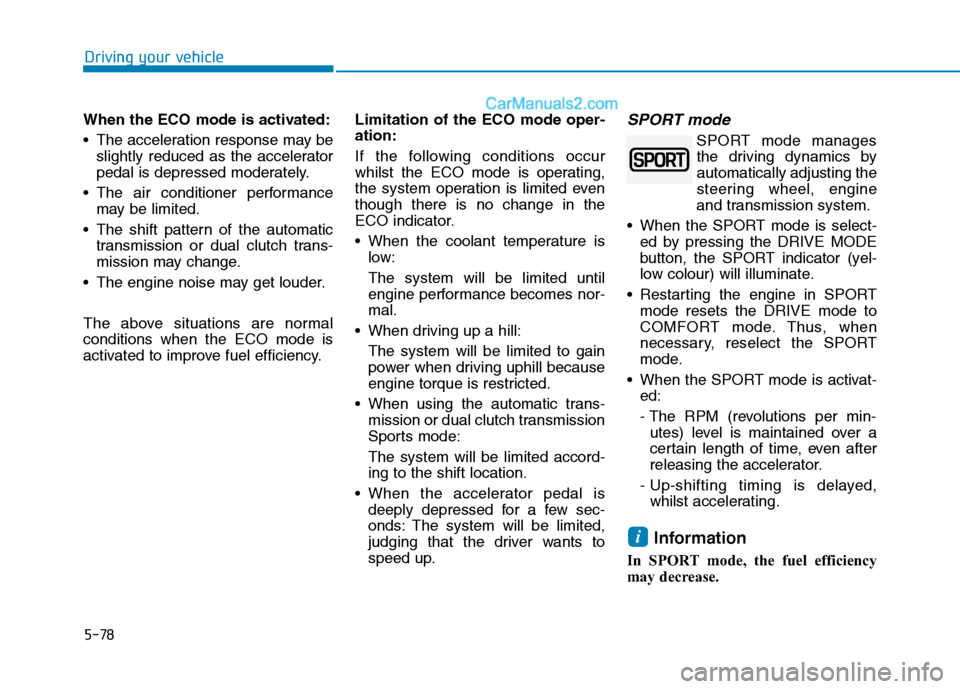
5-78
Driving your vehicle
When the ECO mode is activated:
The acceleration response may be
slightly reduced as the accelerator
pedal is depressed moderately.
The air conditioner performance
may be limited.
The shift pattern of the automatic
transmission or dual clutch trans-
mission may change.
The engine noise may get louder.
The above situations are normal
conditions when the ECO mode is
activated to improve fuel efficiency.Limitation of the ECO mode oper-
ation:
If the following conditions occur
whilst the ECO mode is operating,
the system operation is limited even
though there is no change in the
ECO indicator.
When the coolant temperature is
low:
The system will be limited until
engine performance becomes nor-
mal.
When driving up a hill:
The system will be limited to gain
power when driving uphill because
engine torque is restricted.
When using the automatic trans-
mission or dual clutch transmission
Sports mode:
The system will be limited accord-
ing to the shift location.
When the accelerator pedal is
deeply depressed for a few sec-
onds: The system will be limited,
judging that the driver wants to
speed up.
SPORT mode
SPORT mode manages
the driving dynamics by
automatically adjusting the
steering wheel, engine
and transmission system.
When the SPORT mode is select-
ed by pressing the DRIVE MODE
button, the SPORT indicator (yel-
low colour) will illuminate.
Restarting the engine in SPORT
mode resets the DRIVE mode to
COMFORT mode. Thus, when
necessary, reselect the SPORT
mode.
When the SPORT mode is activat-
ed:
- The RPM (revolutions per min-
utes) level is maintained over a
certain length of time, even after
releasing the accelerator.
- Up-shifting timing is delayed,
whilst accelerating.
Information
In SPORT mode, the fuel efficiency
may decrease.
i
Page 396 of 637
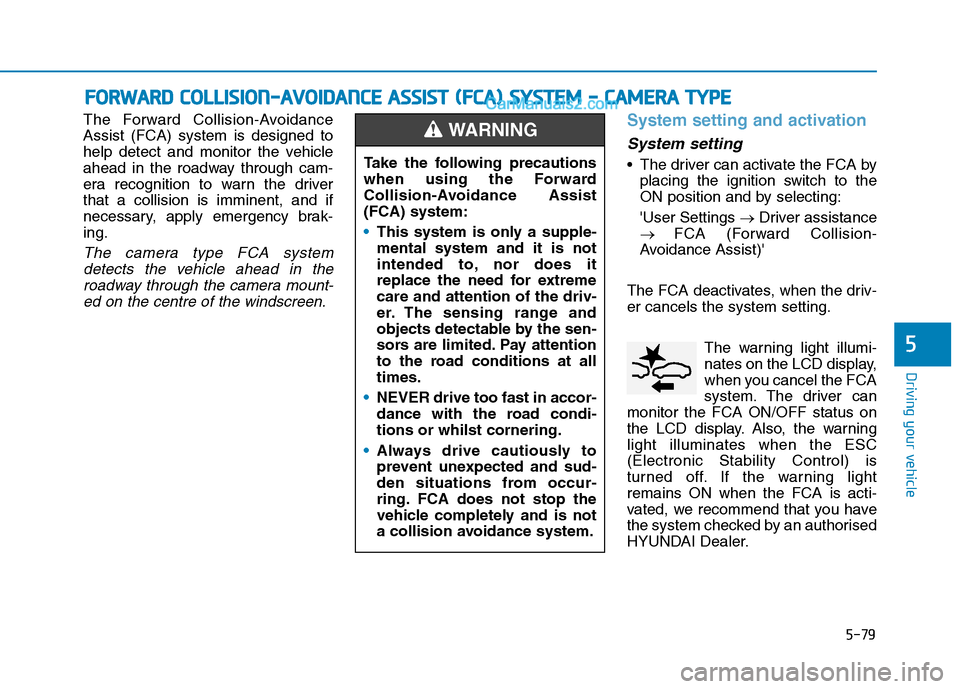
5-79
Driving your vehicle
The Forward Collision-Avoidance
Assist (FCA) system is designed to
help detect and monitor the vehicle
ahead in the roadway through cam-
era recognition to warn the driver
that a collision is imminent, and if
necessary, apply emergency brak-
ing.
The camera type FCA system
detects the vehicle ahead in the
roadway through the camera mount-
ed on the centre of the windscreen.
System setting and activation
System setting
The driver can activate the FCA by
placing the ignition switch to the
ON position and by selecting:
'User Settings →Driver assistance
→ FCA (Forward Collision-
Avoidance Assist)'
The FCA deactivates, when the driv-
er cancels the system setting.
The warning light illumi-
nates on the LCD display,
when you cancel the FCA
system. The driver can
monitor the FCA ON/OFF status on
the LCD display. Also, the warning
light illuminates when the ESC
(Electronic Stability Control) is
turned off. If the warning light
remains ON when the FCA is acti-
vated, we recommend that you have
the system checked by an authorised
HYUNDAI Dealer.
F FO
OR
RW
WA
AR
RD
D
C
CO
OL
LL
LI
IS
SI
IO
ON
N-
-A
AV
VO
OI
ID
DA
AN
NC
CE
E
A
AS
SS
SI
IS
ST
T
(
(F
FC
CA
A)
)
S
SY
YS
ST
TE
EM
M
-
-
C
CA
AM
ME
ER
RA
A
T
TY
YP
PE
E
5
Take the following precautions
when using the Forward
Collision-Avoidance Assist
(FCA) system:
This system is only a supple-
mental system and it is not
intended to, nor does it
replace the need for extreme
care and attention of the driv-
er. The sensing range and
objects detectable by the sen-
sors are limited. Pay attention
to the road conditions at all
times.
NEVER drive too fast in accor-
dance with the road condi-
tions or whilst cornering.
Always drive cautiously to
prevent unexpected and sud-
den situations from occur-
ring. FCA does not stop the
vehicle completely and is not
a collision avoidance system.
WARNING
Page 397 of 637
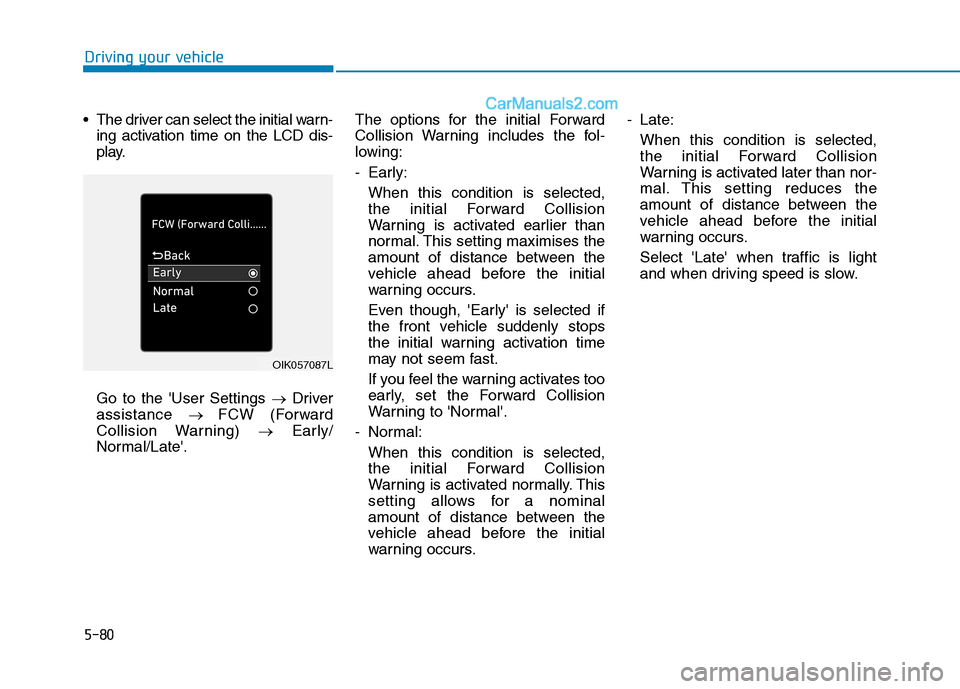
5-80
The driver can select the initial warn-
ing activation time on the LCD dis-
play.
Go to the 'User Settings →Driver
assistance → FCW (Forward
Collision Warning) →Early/
Normal/Late'.The options for the initial Forward
Collision Warning includes the fol-
lowing:
- Early:
When this condition is selected,
the initial Forward Collision
Warning is activated earlier than
normal. This setting maximises the
amount of distance between the
vehicle ahead before the initial
warning occurs.
Even though, 'Early' is selected if
the front vehicle suddenly stops
the initial warning activation time
may not seem fast.
If you feel the warning activates too
early, set the Forward Collision
Warning to 'Normal'.
- Normal:
When this condition is selected,
the initial Forward Collision
Warning is activated normally. This
setting allows for a nominal
amount of distance between the
vehicle ahead before the initial
warning occurs.- Late:
When this condition is selected,
the initial Forward Collision
Warning is activated later than nor-
mal. This setting reduces the
amount of distance between the
vehicle ahead before the initial
warning occurs.
Select 'Late' when traffic is light
and when driving speed is slow.
Driving your vehicle
OIK057087L
Page 398 of 637
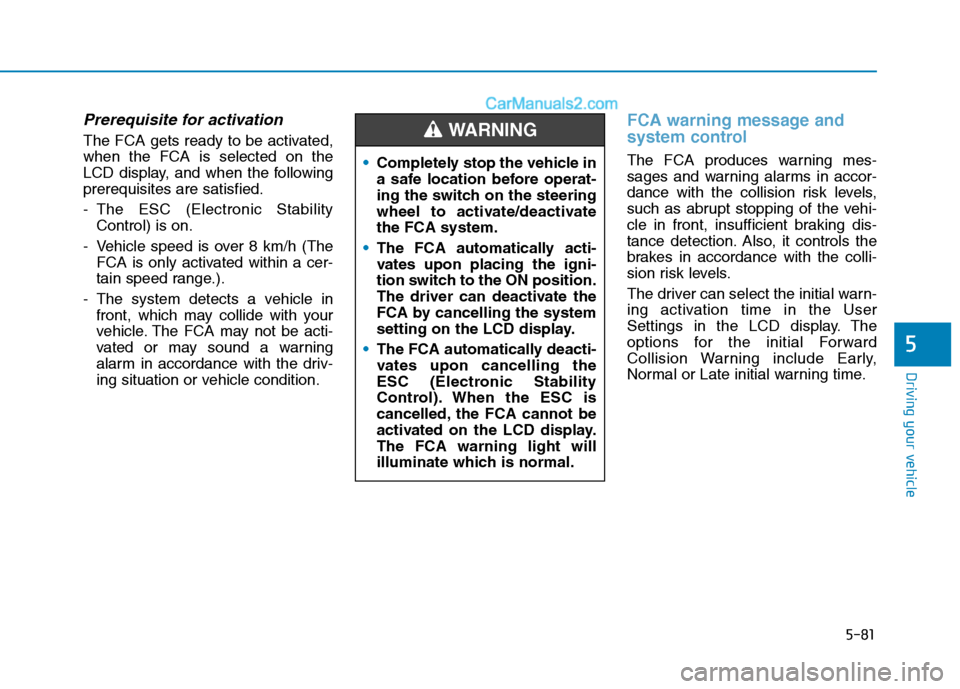
5-81
Driving your vehicle
Prerequisite for activation
The FCA gets ready to be activated,
when the FCA is selected on the
LCD display, and when the following
prerequisites are satisfied.
- The ESC (Electronic Stability
Control) is on.
- Vehicle speed is over 8 km/h (The
FCA is only activated within a cer-
tain speed range.).
- The system detects a vehicle in
front, which may collide with your
vehicle. The FCA may not be acti-
vated or may sound a warning
alarm in accordance with the driv-
ing situation or vehicle condition.
FCA warning message and
system control
The FCA produces warning mes-
sages and warning alarms in accor-
dance with the collision risk levels,
such as abrupt stopping of the vehi-
cle in front, insufficient braking dis-
tance detection. Also, it controls the
brakes in accordance with the colli-
sion risk levels.
The driver can select the initial warn-
ing activation time in the User
Settings in the LCD display. The
options for the initial Forward
Collision Warning include Early,
Normal or Late initial warning time.
5
Completely stop the vehicle in
a safe location before operat-
ing the switch on the steering
wheel to activate/deactivate
the FCA system.
The FCA automatically acti-
vates upon placing the igni-
tion switch to the ON position.
The driver can deactivate the
FCA by cancelling the system
setting on the LCD display.
The FCA automatically deacti-
vates upon cancelling the
ESC (Electronic Stability
Control). When the ESC is
cancelled, the FCA cannot be
activated on the LCD display.
The FCA warning light will
illuminate which is normal.
WARNING
Page 399 of 637
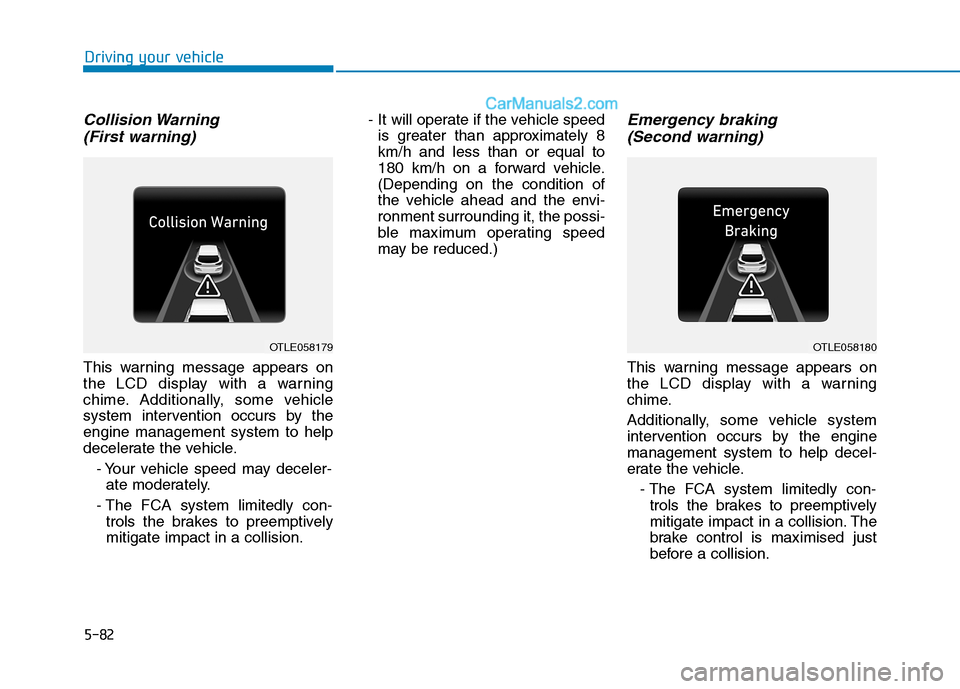
5-82
Collision Warning
(First warning)
This warning message appears on
the LCD display with a warning
chime. Additionally, some vehicle
system intervention occurs by the
engine management system to help
decelerate the vehicle.
- Your vehicle speed may deceler-
ate moderately.
- The FCA system limitedly con-
trols the brakes to preemptively
mitigate impact in a collision.- It will operate if the vehicle speed
is greater than approximately 8
km/h and less than or equal to
180 km/h on a forward vehicle.
(Depending on the condition of
the vehicle ahead and the envi-
ronment surrounding it, the possi-
ble maximum operating speed
may be reduced.)
Emergency braking
(Second warning)
This warning message appears on
the LCD display with a warning
chime.
Additionally, some vehicle system
intervention occurs by the engine
management system to help decel-
erate the vehicle.
- The FCA system limitedly con-
trols the brakes to preemptively
mitigate impact in a collision. The
brake control is maximised just
before a collision.
Driving your vehicle
OTLE058179OTLE058180
Page 400 of 637
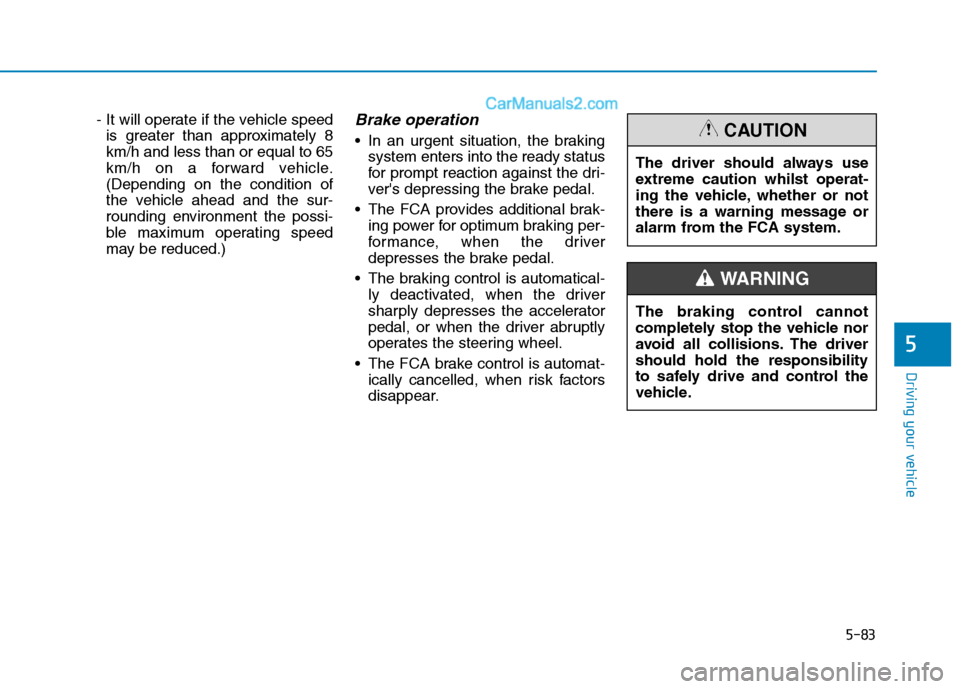
5-83
Driving your vehicle
5
- It will operate if the vehicle speed
is greater than approximately 8
km/h and less than or equal to 65
km/h on a forward vehicle.
(Depending on the condition of
the vehicle ahead and the sur-
rounding environment the possi-
ble maximum operating speed
may be reduced.)Brake operation
In an urgent situation, the braking
system enters into the ready status
for prompt reaction against the dri-
ver's depressing the brake pedal.
The FCA provides additional brak-
ing power for optimum braking per-
formance, when the driver
depresses the brake pedal.
The braking control is automatical-
ly deactivated, when the driver
sharply depresses the accelerator
pedal, or when the driver abruptly
operates the steering wheel.
The FCA brake control is automat-
ically cancelled, when risk factors
disappear.The driver should always use
extreme caution whilst operat-
ing the vehicle, whether or not
there is a warning message or
alarm from the FCA system.CAUTION
The braking control cannot
completely stop the vehicle nor
avoid all collisions. The driver
should hold the responsibility
to safely drive and control the
vehicle.
WARNING